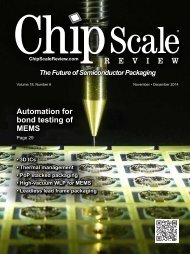DSS2015-final-lr
DSS2015-final-lr
DSS2015-final-lr
- No tags were found...
You also want an ePaper? Increase the reach of your titles
YUMPU automatically turns print PDFs into web optimized ePapers that Google loves.
Fiber Optic Sensors ProgramThis track highlights papers from both Defense + Security andSensing Technology + Applications that showcase the latest in fiber optic sensors.FIBER OPTIC SENSOR COURSESFundamentals of Fiber Optic Sensor Design and TechnologySC1160Instructors: Eric Udd / Robert LiebermanSchedule: Tuesday 21 April, 8:30 am - 5:30 pmPrice: $620 members / $715 non-membersPrice includes the text Fiber Optic Sensor Field Guide (SPIE Press, 2015), byWilliam B. Spillman and Eric Udd.FIBER OPTIC SENSOR PRESENTATIONSView the Fiber Optic Sensors and Applications XII conference(Conf. 9480) on page 116.(FOLLOWING PAPERS ORDERED NUMERICALLYBY CONFERENCE PAPER NUMBER)MONDAY 20 APRILLight-directed functionalization methods for high-resolutionoptical fiber based biosensorsPAPER 9486-5 · 4/20/2015 · 10:45 amAuthor(s): Leyla N. Kahyaoglu, Purdue Univ. (USA), et al.Conference 9486: Advanced Environmental, Chemical, and Biological SensingTechnologies XIISESSION 2: Biosensors IIDispersive Raman spectroscopy excited at 1064nm to classifythe botanic origin of honeys from Calabria and quantify thesugar profilePaper 9486-14 · 4/20/2015 3:15 pmAuthor(s): Anna G. Mignani, Istituto di Fisica Applicata Nello Carrara (Italy), et al.Conference 9486: Advanced Environmental, Chemical, and Biological SensingTechnologies XIISESSION 4: Chemical Sensing and AnalysisRaman spectroscopy with excitation at 1064nm and a grating-based detecting unitwas used to measure a set of 13 honey samples from the Calabria region, locatedin the South of Italy. Three different botanic origins were considered: chestnut,citrus, and acacia, respectively. The sugar profile of these samples was available,which was previously obtained by means of destructive analytical measurements.A chemometric processing of the Raman spectra allowed for obtaining an excellentclustering according to the botanic origin, as well a good predictive model forquantifying the most abundant sugars: glucose, fructose, isomaltose, maltose, andother minor sugars such as erlose, theralose and kojibioseTUESDAY 21 APRILOEM fiber laser rangefinder for long-distance measurementPAPER 9465-5 · 4/21/2015 · 9:20 amAuthor(s): Alexandre Corman, SensUp (France), et al.Conference 9465A: Laser Radar Technology and Applications XXSESSION 1: System Design/DemonstrationSensUp designs, manufactures and commercializes OEM electro-optical systemsbased on laser technology. This presentation is focused on the development of thefirst OEM rangefinder based on fiber laser technology. The flexibility provided bythis laser source coupled with the important peak power of solid-state lasers andthe huge repetition rate of laser diodes, enable us to fit the SWAP requirementsof the optronic market integrators. It actually turns out to be a real alternative toother technologies usually used in range finding systems.LandSafe precision flight instrumentation system for rotorcraftoperations in degraded environmentsPAPER 9471-5 · 4/21/2015 · 9:30 amAuthor(s): Pri Mamidipudi, Optical Air Data Systems, LLC (USA), et al.Conference 9471: Degraded Visual Environments: Enhanced, Synthetic, andExternal Vision Solutions 2015SESSION 1: DVE Sensors IHelicopter hover, landing, and take-off operations in darkness, dust, fog, rain, snow,and high winds is an integral part of military and commercial flight operations.OADS has developed and flight-tested a standalone LDV-based optical sensor suitecapable of precisely measuring and reporting height above ground, groundspeed,ground drift, and air data at an FCS capable data rate from a helicopter platformunder all environmental conditions. Details about the sensor and recent flight testresults from multiple platforms will be presented.Application of a LED-based reflectance sensor for theassessing in situ the lycopene content of tomatoes(Lycopersicon esculentum Mill.)Paper 9488-5 · 4/21/2015 · 2:55 pmAuthor(s): Anna G. Mignani, Istituto di Fisica Applicata Nello Carrara (Italy), et al.Conference 9488: Sensing for Agriculture and Food Quality and Safety VIISESSION 1: Sensing for Food Quality and Safety IA portable and low-cost device is presented for the non-destructive assessmentof tomato lycopene in the field. It is a compact colorimeter making used of LEDsfor illumination and a miniaturized spectrometer as detector. Partial Least SquaresRegression (PLSR) was used to correlate spectral data to the tomato lycopenecontent, demonstrating successful results.A miniature fiber-optic sensor for high-resolution and highspeedtemperature and flow sensing in ocean environmentPAPER 9459-19 · 4/21/2015 · 4:40 pmAuthor(s): Ming Han, Univ. of Nebraska-Lincoln (USA), et al.Conference 9459: Ocean Sensing and Monitoring VIISESSION 4: Underwater Optical Imaging and Ranging IIIn oceanography, the underwater thermal structures are critical for analyzing theenergy events, monitoring material transfer, transmitting optical signals, etc. In thispaper, we present an optical fiber sensor consisting of a thin piece of silicon waferwhich forms a Fabry-Perot interferometer for the high-resolution and high-speedtemperature profiling. A new data processing method has also been developed toreduce the signal-to-noise ratio of the system. Experimental results indicate thatthe fiber-optic temperature sensor can achieve a temperature resolution ~0.001degree Celsius with a sampling frequency higher than 500 Hz. The ability of thesensor used as a water flow probe will also be demonstrated.A plastic optical fiber biosensor for e. coliPAPER 9486-29 · 4/21/2015 · 6:00 pmAuthor(s): Domingos M. C. Rodrigues, Univ. Federal of Rio de Janeiro (Brazil),et al.Conference 9486: Advanced Environmental, Chemical, and Biological SensingTechnologies XIITUESDAY POSTER SESSION: Interactive Poster Session: Tuesday EveningThis work presents a plastic optic fiber biosensor to detect Escherichia coli. Differentprobe shapes were tested: U-shaped with different radiuses, coil-shaped andmeander-shaped. In calibration, we used solutions of sucrose for obtaining refractiveindexes in the range 1.33 – 1.39 equivalent to water and bacteria, respectively. Thesetup consists of a LED connected to the probe and driven by microcontroller. Inthe opposite fiber end, the light received by a photodiode is amplified, and theoutput voltage varies accordingly to the captured bacteria. Measurement resultsfor concentration readings of 104 CFU/mL are obtained in less than 10 minutes.166 SPIE DSS 2015 · www.spie.org/dss



